
It’s been awesome to see our dojos buzzing over the last couple of months, with lots of tournaments, seminars and gradings, including Black Belt Gradings. 🖤💛💙💚🧡
Well done to everyone who has advanced their karate journey over this time, whether it be with new grade, a medal, learning new skills or finding ways to sharpen your kata.
Please wait while the album loads below or click here to view on Facebook.



